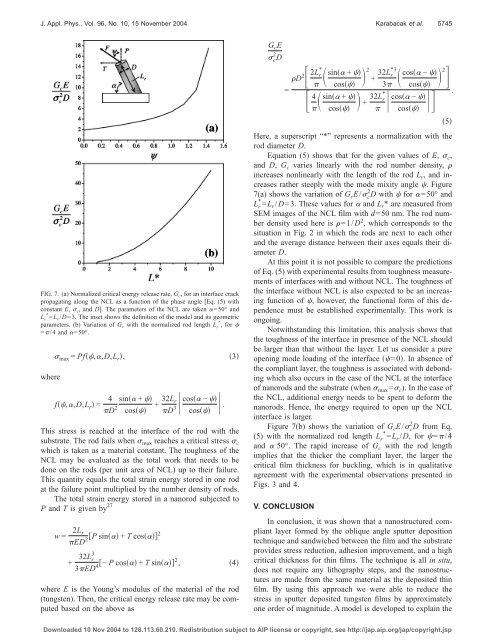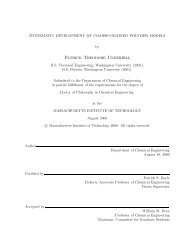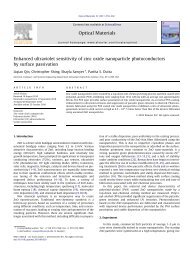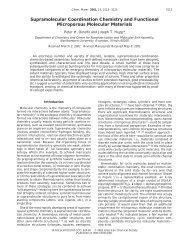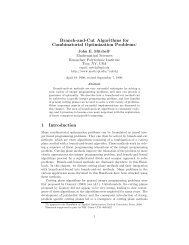Stress reduction in tungsten films using nanostructured compliant ...
Stress reduction in tungsten films using nanostructured compliant ...
Stress reduction in tungsten films using nanostructured compliant ...
Create successful ePaper yourself
Turn your PDF publications into a flip-book with our unique Google optimized e-Paper software.
J. Appl. Phys., Vol. 96, No. 10, 15 November 2004 Karabacak et al. 5745<br />
FIG. 7. (a) Normalized critical energy release rate, Gc, for an <strong>in</strong>terface crack<br />
propagat<strong>in</strong>g along the NCL as a function of the phase angle [Eq. (5) with<br />
constant E, c,andD]. The parameters of the NCL are taken =50° and<br />
*<br />
Lr =Lr/D=3. The <strong>in</strong>set shows the def<strong>in</strong>ition of the model and its geometric<br />
*<br />
parameters. (b) Variation of Gc with the normalized rod length Lr , for <br />
=/4 and =50°.<br />
max = Pf,,D,L r, 3<br />
where<br />
f,,D,L r = 4<br />
D2 s<strong>in</strong> + <br />
cos + 32Lr cos − <br />
D3 .<br />
cos<br />
This stress is reached at the <strong>in</strong>terface of the rod with the<br />
substrate. The rod fails when max reaches a critical stress c<br />
which is taken as a material constant. The toughness of the<br />
NCL may be evaluated as the total work that needs to be<br />
done on the rods (per unit area of NCL) up to their failure.<br />
This quantity equals the total stra<strong>in</strong> energy stored <strong>in</strong> one rod<br />
at the failure po<strong>in</strong>t multiplied by the number density of rods.<br />
The total stra<strong>in</strong> energy stored <strong>in</strong> a nanorod subjected to<br />
P and T is given by 27<br />
w = 2Lr ED2P s<strong>in</strong> + T cos2<br />
+ 32L 3<br />
r<br />
3ED4− P cos + T s<strong>in</strong>2 , 4<br />
where E is the Young’s modulus of the material of the rod<br />
(<strong>tungsten</strong>). Then, the critical energy release rate may be computed<br />
based on the above as<br />
G cE<br />
2<br />
cD =<br />
D2 2L *<br />
2<br />
r s<strong>in</strong> + <br />
cos<br />
4<br />
<br />
+<br />
cos 32L *<br />
r<br />
s<strong>in</strong> + <br />
+ 32L *3<br />
r cos − <br />
3 cos<br />
<br />
cos − <br />
cos <br />
Here, a superscript “*” represents a normalization with the<br />
rod diameter D.<br />
Equation (5) shows that for the given values of E, c, and D, Gc varies l<strong>in</strong>early with the rod number density, <br />
<strong>in</strong>creases nonl<strong>in</strong>early with the length of the rod Lr, and <strong>in</strong>creases<br />
rather steeply with the mode mixity angle . Figure<br />
2<br />
7(a) shows the variation of GcE/ cD<br />
with for =50° and<br />
L r<br />
2<br />
5<br />
* =Lr/D=3. These values for and L r* are measured from<br />
SEM images of the NCL film with d=50 nm. The rod number<br />
density used here is =1/D2 , which corresponds to the<br />
situation <strong>in</strong> Fig. 2 <strong>in</strong> which the rods are next to each other<br />
and the average distance between their axes equals their diameter<br />
D.<br />
At this po<strong>in</strong>t it is not possible to compare the predictions<br />
of Eq. (5) with experimental results from toughness measurements<br />
of <strong>in</strong>terfaces with and without NCL. The toughness of<br />
the <strong>in</strong>terface without NCL is also expected to be an <strong>in</strong>creas<strong>in</strong>g<br />
function of , however, the functional form of this dependence<br />
must be established experimentally. This work is<br />
ongo<strong>in</strong>g.<br />
Notwithstand<strong>in</strong>g this limitation, this analysis shows that<br />
the toughness of the <strong>in</strong>terface <strong>in</strong> presence of the NCL should<br />
be larger than that without the layer. Let us consider a pure<br />
open<strong>in</strong>g mode load<strong>in</strong>g of the <strong>in</strong>terface =0. In absence of<br />
the <strong>compliant</strong> layer, the toughness is associated with debond<strong>in</strong>g<br />
which also occurs <strong>in</strong> the case of the NCL at the <strong>in</strong>terface<br />
of nanorods and the substrate (when max= c). In the case of<br />
the NCL, additional energy needs to be spent to deform the<br />
nanorods. Hence, the energy required to open up the NCL<br />
<strong>in</strong>terface is larger.<br />
2<br />
Figure 7(b) shows the variation of GcE/ cD<br />
from Eq.<br />
*<br />
(5) with the normalized rod length Lr =Lr/D, for =/4<br />
and 50°. The rapid <strong>in</strong>crease of G c with the rod length<br />
implies that the thicker the <strong>compliant</strong> layer, the larger the<br />
critical film thickness for buckl<strong>in</strong>g, which is <strong>in</strong> qualitative<br />
agreement with the experimental observations presented <strong>in</strong><br />
Figs. 3 and 4.<br />
V. CONCLUSION<br />
In conclusion, it was shown that a <strong>nanostructured</strong> <strong>compliant</strong><br />
layer formed by the oblique angle sputter deposition<br />
technique and sandwiched between the film and the substrate<br />
provides stress <strong>reduction</strong>, adhesion improvement, and a high<br />
critical thickness for th<strong>in</strong> <strong>films</strong>. The technique is all <strong>in</strong> situ,<br />
does not require any lithography steps, and the nanostructures<br />
are made from the same material as the deposited th<strong>in</strong><br />
film. By us<strong>in</strong>g this approach we were able to reduce the<br />
stress <strong>in</strong> sputter deposited <strong>tungsten</strong> <strong>films</strong> by approximately<br />
one order of magnitude. A model is developed to expla<strong>in</strong> the<br />
Downloaded 10 Nov 2004 to 128.113.60.210. Redistribution subject to AIP license or copyright, see http://jap.aip.org/jap/copyright.jsp<br />
.


